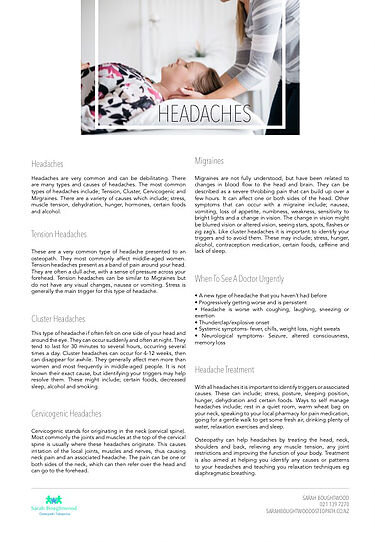Verve Magazine - Headaches
Headaches are very common and can be debilitating. There are many types and causes of headaches. The most common types of headaches include; Tension, Cluster, Cervicogenic and Mirgraines. There are a variety of causes which include; stress, muscle tension, dehydration, hunger, hormones, certain foods and alcohol.
Tension Headaches
These are a very common type of headache presented to an osteopath. They most commonly affect middle-aged women. Tension headaches present as a band of pain around your head. They are often a dull ache, with a sense of pressure across your forehead. Tension headaches can be similar to Migraines but do not have any visual changes, nausea or vomiting. Stress is generally the main trigger for this type of headache.
Cluster Headaches
This type of headache if often felt on one side of your head and around the eye. They can occur suddenly and often at night. They tend to last for 30 minutes to several hours, occurring several times a day. Cluster headaches can occur for 4-12 weeks, then can disappear for awhile. They generally affect men more than women and most frequently in middle-aged people. It is not known their exact cause, but identifying your triggers may help resolve them. These might include; certain foods, decreased sleep, alcohol and smoking.
Cervicogenic Headaches
Cervicogenic stands for originating in the neck (cervical spine). Most commonly the joints and muscles at the top of the cervical spine is usually where these headaches originate. This causes irritation of the local joints, muscles and nerves, thus causing neck pain and an associated headache. The pain can be one or both sides of the neck, which can then refer over the head and can go to the forehead.
Migraines
Migraines are not fully understood, but have been related to changes in blood ow to the head and brain. They can be described as a severe throbbing pain that can build up over a few hours. It can affect one or both sides of the head. Other symptoms that can occur with a migraine include; nausea, vomiting, loss of appetite, numbness, weakness, sensitivity to bright lights and a change in vision. The change in vision might be blurred vision or altered vision, seeing stars, spots, ashes or zig zag’s. Like cluster headaches it is important to identify your triggers and to avoid them. These may include; stress, hunger, alcohol, contraception medication, certain foods, caffeine and lack of sleep.
When To See A Doctor Urgently
• A new type of headache that you haven’t had before
• Progressively getting worse and is persistent
• Headache is worse with coughing, laughing, sneezing or exertion
• Thunderclap/explosive onset
• Systemic symptoms- fever, chills, weight loss, night sweats
• Neurological symptoms- Seizure, altered consciousness, memory loss
Headache Treatment
With all headaches it is important to identify triggers or associated causes. These can include; stress, posture, sleeping position, hunger, dehydration and certain foods. Ways to self manage headaches include; rest in a quiet room, warm wheat bag on your neck, speaking to your local pharmacy for pain medication, going for a gentle walk to get some fresh air, drinking plenty of water, relaxation exercises and sleep.
Osteopathy can help headaches by treating the head, neck, shoulders and back, relieving any muscle tension, any joint restrictions and improving the function of your body. Treatment is also aimed at helping you identify any causes or patterns to your headaches and teaching you relaxation techniques eg diaphragmatic breathing.

